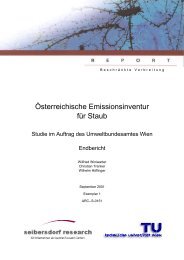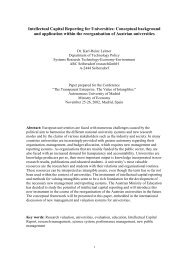ALPMON FINAL REPORT - ARC systems research
ALPMON FINAL REPORT - ARC systems research
ALPMON FINAL REPORT - ARC systems research
Create successful ePaper yourself
Turn your PDF publications into a flip-book with our unique Google optimized e-Paper software.
Contract ENV4-CT96-0359 <strong>ALPMON</strong><br />
� The perspectives offered by image analysis <strong>systems</strong> working object oriented like the tested<br />
eCognition from the Delphi2 Creative Technologies company, which seems to be the first step<br />
to reduce the problems connected to high resolution data and in general with data fusion.<br />
Further achievements with respect to feature extraction, shape, segmentation and object<br />
based classification are reached with the ClassTool software currently developed at JR.<br />
Limitations of the present as well as perspectives of the future are discussed in more detail in section<br />
3.4. The main scientific developments were achieved within the feasibility studies, where new method<br />
developments were necessary.<br />
The development and implementation of the image fusion algorithm had a significant impact on the<br />
classification and visualisation of remotely sensed images. The classification of meta classes, such as<br />
the production of a forest/non forest mask, could be improved. For the visualisation of multi-resolution<br />
images the fusion method solved the problem of different pixel sizes and thus suppressed the aliasing<br />
effect in the resulting images. The methodology used for the fusion algorithm was presented to and<br />
discussed within the scientific community during several conferences (Steinnocher, 1998, Steinnocher,<br />
1999). For example, the University of Freiburg used this method to create a fusion image as basis not<br />
only for visual interpretation but also for visualisation tasks (WP12). A photorealistic background for<br />
tourist information with a ground resolution of 2m was derived out of Landsat 5 TM data and KVR-1000<br />
data.<br />
For the aim 'tourist information' a tourist information system was programmed by using ArvView's<br />
programming language Avenue. In this tourist information system it is possible to choose hiking routes<br />
by free choice and get describing information for this route. This enlarges the possibilities of a tourist<br />
office: not only advised routes but free choice of the route with describing information like length,<br />
altitude profile, landscape factors.<br />
For the modelling of water run-off using the ASGI model the estimation of soil characteristics could<br />
be significantly improved by fusion of small scale geological and soil type maps. Generally, no<br />
convenient and wall to wall soil type information is available for alpine areas. Furthermore, it was for<br />
the first time that land cover classification results could be implemented as one main parameter into<br />
the ASGI water run-off model for an alpine region.<br />
The original scientific added value of the erosion risk feasibility study is summarised in the following<br />
points:<br />
� The use of a land cover map derived from satellite as basic input for the erosion model.<br />
� The development of an erosion model based on the concept of risk instead of the estimation of the<br />
annual amount of ablated material. The concept of risk is more suitable for land planning.<br />
� The consideration of several mass erosion phenomena typical of Alpine environment.<br />
� The use of two different sub-models (DA and SCS-CN) to take into account the static component<br />
of the risk, related to soil properties and slope, and the dynamic component of risk, which depends<br />
upon the intensity of the run-off.<br />
� The integration (FSTAB) of the above mentioned sub-models by means of an inference engine<br />
based on fuzzy set logic. Fuzzy logic is viable method to manage in a rigorous way uncertain<br />
situations where: 1) data accuracy is highly heterogeneous (e.g.: land cover vs. soil map) ; 2)<br />
interpretation criteria cannot be defined rigorously because of vague definitions (e.g. the concept of<br />
risk) and lack of detailed information.<br />
The avalanche risk assessment mainly made profit from the classification of winter satellite images<br />
and introduction of these results into a multi-temporal classification approach. This for the first time<br />
enabled the separation of low growing tree species, such as dwarf mountain pine and green alder,<br />
from the high growing tree species, which is not possible by their very similar spectral characteristics.<br />
For the transformation of the classification results in the test sites to the corresponding CORINE land<br />
cover maps a post-classification algorithm was developed (Steinnocher 1996). Due to the large<br />
differences in scale this algorithm had to be extended by an iterative shrinking method, in order to<br />
generalise the single land cover units to the minimum mapping unit of the CORINE land cover maps.<br />
The entire post-processing has been described and published in Steinnocher et al. (2000).<br />
JR, RSDE, ALU, LMU, Seibersdorf, WSL 72




